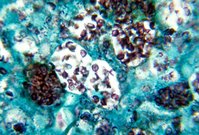What is histoplasmosis?
Histoplasmosis (say this: hiss-toe-plaz-mo-sis) is an infection caused by a fungus. The infection is in your lungs. In severe cases, it could spread through your whole body.
How did I get histoplasmosis?
The fungus that causes histoplasmosis grows in the ground. Farming, gardening, or any activity that disturbs the soil can let fungus spores get into the air. If you breathe in those spores, you can get the infection.
You can't catch histoplasmosis from another person or from an animal. Birds do not carry the infection, but their droppings provide food for the fungus in the ground. Bats can also get infected with histoplasmosis. Their droppings feed the fungus in the ground and can also be a source of infection for people.
Where are histoplasmosis infections common?
Histoplasmosis occurs in places that have moderate temperatures and moisture. It is very common in people who live in the Ohio and Mississippi river valleys.
Who is most likely to get histoplasmosis?
Forty million people in the United States have been infected with histoplasmosis. About a half million new cases occur each year. Most infected people have few or no symptoms.
Severe infections may develop in children under age 2 and in adults older than 55. People who have human immunodeficiency virus (HIV) infection or cancer, and those who are taking some medicines are more likely to get it. A chronic infection can occur in patients with lung diseases like emphysema (say this: em-fa-see-ma).
How does my doctor know I am infected?
Most healthy people who are infected with this fungus never have any symptoms, because their bodies fight off the disease. In people who do get symptoms, fever, headache, cough, chills, sweats, chest pain, fatigue, muscle aches, and weight loss are the most common.
Your doctor can test your blood or urine, or take a sample of tissue for testing if he or she thinks that you might have histoplasmosis. Chest x-rays are helpful, but your doctor can't be sure you have histoplasmosis just by looking at an x-ray.
How is histoplasmosis treated?
The treatment depends on how bad the infection is and how long the illness has lasted. Many people don't need any treatment. Some people have to take an antifungal medicine. If you need to take medicine for this fungus, your doctor will watch out for possible bad effects on your kidney or liver from the medicine.
What can I expect?
Some people have to go to the hospital to get oxygen therapy and intravenous fluids. Others can be treated at home. Most people do well with treatment. You may need to take medicine for weeks or months. If you have acquired immunodeficiency syndrome (AIDS), you might take this medicine for the rest of your life.
Is there any way to not get histoplasmosis?
The best way to not get this infection is to stay away from places where you could breathe in contaminated dust. Spraying the area with water can reduce the dust that gets stirred up by cleaning chicken coops or digging in the dirt. If you work in contaminated areas, you can wear protective clothing and face masks.
COPYRIGHT 2002 American Academy of Family Physicians
COPYRIGHT 2003 Gale Group



